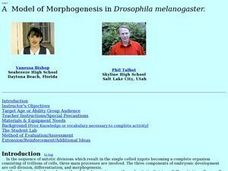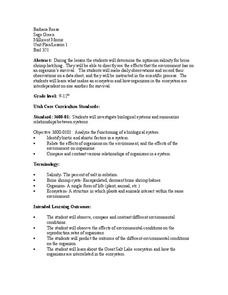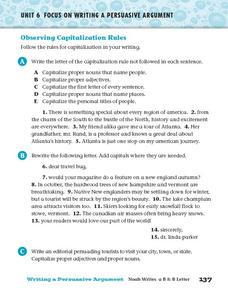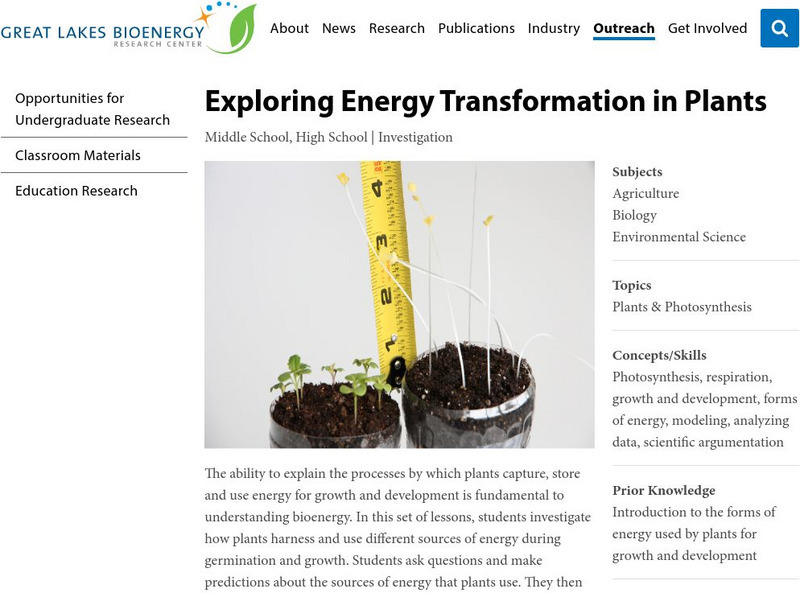Curated OER
Everyday vs. Extreme Relationships with Nature
Students examine the interactions with nature and the environment. They discover where water comes from and ways to conserve water. They also examine energy sources and consumption.
Curated OER
A Model of Morphogenesis in Drosophila Melanogaster
Students investigate the following scientific terms and ideas: rates of diffusion, the role of morphogens in the development of larva, the chemical dynamics of a cell, and the significance of embryo polarity during development.
Curated OER
Excited about Expression!
Students discuss what expression is and listen to the teacher read a page without expression. They give suggestions of how the reading could be more expressive and exciting and observe as they are written on the board. They then discuss...
Curated OER
Hatching Brine Shrimp
Third graders investigate the environment that is considered favorable for brine shrimp hatching. The salinity level is of particular interest in the observations because the optimum level is needed for survival. They make daily...
Curated OER
What Is A Dinosaur?
Pupils use the question of "What is a dinosaur?" in order to establish the context for a class investigation. They use a variety of resources in order to gather information. Students compare and contrast the similarities or differences...
Curated OER
Strangers in Their Own Land
Students use interview techniques to explore the traditional wisdom of fishers, farmers, First Nations, and other peoples whose close relationship with nature gives them a deeper understanding of, and sensitivity toward, climatic cycles...
Curated OER
Social Studies: The Fremont People
Students examine the culture of the Fremont people prior to creating their own copies of their pottery. With teacher-supplied clay, students follow instruction sheets to make their own replicas based on the Fremont pottery designs.
Curated OER
Observing Capitalization Rules
For this capitalization worksheet, students complete three activities that help them follow the rules for capitalization in their writing.
Curated OER
Seeing/Reading Photographs Lesson Plan: An Interactive History Discussion
Students analyze and read historic photographs. In this historic photographs lesson, students explore history and writing by looking at photographs. Students discuss the photographs and produce a written record of the historical photograph.
Curated OER
Dig Magazine Archeology Quiz #114
In this Dig Magazine archeology quiz, students answer 12 multiple choice questions complementing the October 2010 issue. Page contains answer and additional resources link.
Curated OER
Brain POP - Volcano
In this volcano worksheet, students complete 15 fill in the blank questions on the basics of volcano structure and volcano trivia.
Curated OER
Rocks Word Search Puzzle
In this literacy worksheet, students look for the words that are related to the concept that is reviewed in the sheet. They also acquire new vocabulary.
Curated OER
Beginning Analogies 9
In this analogies worksheet, students read the word pairs and choose the answer that best expresses a relationship similar to the original pair.
University of Michigan
Michigan Sea Grant: Teaching Great Lakes Science: Fish Identification
In this lesson, students examine the physical characteristics of fish that live in the Great Lakes and identify common features that help species to survive in that environment. Downloadable resources include a fish poster, fish family...
Science Education Resource Center at Carleton College
Serc: How Does the Temperature of the Great Lakes Change Over Time?
This activity allows students to use water surface temperature, bathymetric data, and weather data to look at trends in the water temperature of the Great Lakes.
Other
Great Lakes Bioenergy Research Ctr.: Exploring Energy Transformations in Plants
This set of lessons has students investigate how plants obtain energy from different sources to support their growth and development. Students conduct investigations, make predictions, and construct scientific explanations of the...
Other
Great Lakes Now Virtual Field Trip
Embark on a virtual field trip that covers three main components: coastal wetlands, algae, and lake sturgeon. The videos are short and targeted at middle schoolers.
Utah STEM Foundation
Utah Stem Action Center: Salt Dissolved in Great Salt Lake
In this lesson, students will compare water from a fresh lake to water from the Great Salt Lake to begin to build a conceptual model for how salt dissolves in water. The lesson focuses on students using and developing models of molecules...
Utah STEM Foundation
Utah Stem Action Center: Great Salt Lake Is Changing
For this lesson, students will explore the phenomenon of a shrinking lake and will develop and use models to understand why. Through a simulation game and exploration, students will learn about the effects of a shrinking lake and what we...
Utah STEM Foundation
Utah Stem Action Center: Great Salt Lake Ecosystem
This lesson plan provides an eight-day flow of educational activities in which young scholars use the Great Salt Lake ecosystem to explore food webs and how changes in living and nonliving factors affect different populations.
Utah STEM Foundation
Utah Stem Action Center: Floating on the Great Salt Lake
Through exploring the phenomenon that it is easier to float on salt water than on fresh water, students will develop a conceptual model for molecules and how the arrangement of molecules affects density.
Other
Ohio Dept. Of Education: Lesson Plan: Transportation Systems Grade Four
For this instructional activity unit, students learn about transportation systems, including the Great Lakes canal system, and how modes of transportation has changed over time with advancements in technology. There is a large student...
National Endowment for the Humanities
Neh: Edsit Ement: Anishinabe Ojibwe Chippewa: Culture
Though written for grades 3-5, this lesson plan can be easily changed to help students of all ages learn about the Chippewa people. Additional resources provide historical, cultural, and geographical facts concerning this Native American...
Utah STEM Foundation
Utah Stem Action Center: Pelicans on Gunnison Island
In this lesson, young scholars will explore interactions between a population and the environment as they learn about why so many American white pelicans spend the spring and summer on Gunnison Island in the Great Salt Lake.
Other popular searches
- Great Lakes Worksheet
- Great Lakes Biodiversity
- Great Lakes Map
- Label the Great Lakes
- Maps of Great Lakes
- The Great Lakes
- Michigan's Great Lakes
- Five Great Lakes
- Great Lakes Region
- Great Lakes Lesson Plans
- Traveling the Great Lakes
- Activities the Great Lakes


















